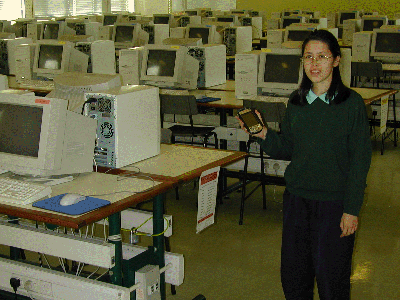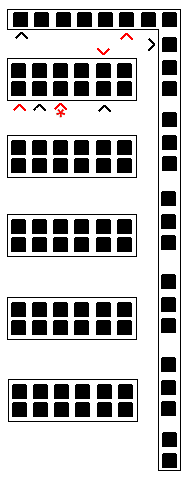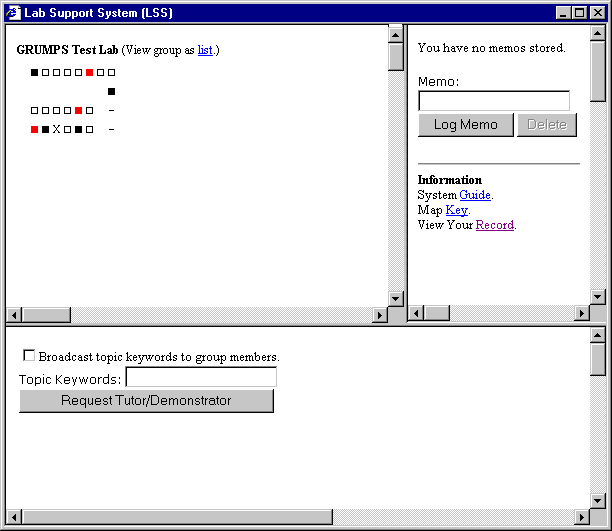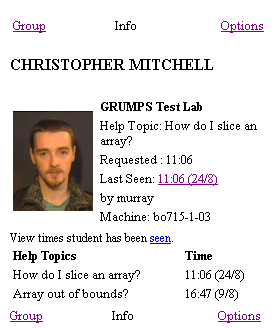
A tutor in the lab
Web site logical path: [www.psy.gla.ac.uk] [~steve] [grumps] [this page]
The start of the summer term saw a first study by the GRUMPS project, in which the first year undergraduate lab tutors in computing science were equipped with handheld devices to provide just-in-time information delivery, and student machines were "bugged" by monitoring software. Students could now be asked to signal for help, not by keeping their hands raised, but by clicking on a custom web page. The resulting help request queue for that tutorial group was supplied to the device carried by the tutor. Other information on that student, such as their name and photo, their history of requesting help and the time since they were last seen, was also available in various views of the group offered to the tutor. However the most important view was a map, showing schematically where in the lab the group's members were, and indicating the order in which they had requested help by superimposed numbers. Tutors could thus choose to visit students in the order of their requests, or in terms of who was nearest, or to visit all students in turn in order of proximity regardless of requests.
The GRUMPS team includes an educational evaluator, Margaret Brown. The data she has gathered allows us to say with some confidence and detail (the full report is on the web site) that the innovation was largely welcomed by staff and students, and to identify some consequent changes in the pattern of their interactions. The running of an improved version in the first year labs from October is planned.

A tutor in the lab

Diagram of the whole lab

The map view available to a group's tutor

Information on one student
In a related development in Australia, the project's Perth collaborator Richard Thomas has used his GRUMPS connection to install software that allows lab tutors to enter student marks electronically on the spot. This is proving popular with tutors by saving clerical paperwork and keeping student progress records instantly up to date. This feature may be introduced here.
The other aspect of the Glagow study was software to record student actions on the computers during labs (over 4.8 million action events were recorded during the one month of the study). In the longer term, two educational benefits are sought from this. From the staff viewpoint, analysis and data mining may uncover patterns useful in managing the course. Quintin Cutts will be leading an effort on this from October onwards. From the student viewpoint, it offers personal data collected automatically on which a student could reflect, and learn to manage aspects of their own learning better. Realising this potential may depend on explicitly supporting it as part of the development of personal "metacognitive" and study skills.
Initially this data collection was seen as a potential problem: by lab support staff as a danger to software reliability, and by students as a threat to their privacy. The former was addressed by designing and testing for reliability, fail-safe characteristics, and ease of control (including shutdown) of this distributed software: the research interest of part of the GRUMPS team. The latter was addressed by equipping the students with a software privacy control, and by inviting discussion: privacy issues are now an important professional topic in computing, so this too has educational value.
As this indicates, GRUMPS is a multidisciplinary project. This study was undertaken partly as a team-gelling exercise to get the project off to a positive start, and in that management sense it has been a huge success (and we even hope to publish a paper on this aspect in a management journal, in addition to the other papers it has generated in the first nine months of GRUMPS). The study was also designed to exercise all the levels in the project. At the top level is the application domain of education, as discussed above. Whether you regard it as a case of ICT transforming our teaching workplace, or of pervasive computing unobtrusively interpenetrating essentially unchanged activities, is an interesting question. At the middle level is a Human Computer Interaction strand addressing the usability of the various kinds of data created. A paper has already been accepted that discusses the use of maps, and the benefit of rotating them to match the direction the student is facing when seeing the map on their lab PC screen. At the underlying level, GRUMPS is a Distributed Information Management project. In the light of this exploratory study, a new software architecture has been designed.
Since that study, GRUMPS has been using summer studentships to further two extensions. One is the instantiation of our international link with Perth, Western Australia: Martin Ritchie was forced to accept a free trip there to install, develop, and maintain the software mentioned above. This is now already in use (it's winter there) in one of their computing labs. Chris Mitchell, a 3rd year summer student in computing science, is developing software support for GRUMPS' next educational adventure: promoting interactivity in lectures by the use of handsets that allow students to register their answers to a displayed question, and display the aggregated answers.
What's next? GRUMPS will soon begin to address its second application area of Bioinformatics. The lab support software (LSS) will be used again in the coming session, while the handsets will be first used in anger in the autumn term (we hope to trial them before that at the Open Day and other smaller venues). An issue for both the LSS and the handsets is managing a transition of funding as well of software and equipment from EPSRC-funded research like GRUMPS, through university-funded development (Vice-Principal Ron Emanuel has used discretionary funds to support the handset purchase, and they will soon be available for use in any university teaching), to regular client-funded use and maintainence (by central services or individual departments supporting their own teaching). However they are in contrast in that while the handsets may prove useful in all departments, the LSS is applicable only to lab classes based on computer use with tutors in attendance, which occurs in only a few places in the university. This illustrates the question of whether teaching quality, methods, and innovation have general aspects true across the university or are mostly tied to a specific host discipline. It is one of the issues likely to be hotly discussed within the university's newly founded Centre for Research in HE.
Web site logical path:
[www.psy.gla.ac.uk]
[~steve]
[grumps]
[this page]
[Top of this page]